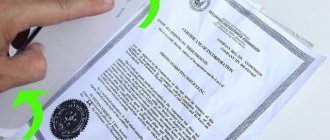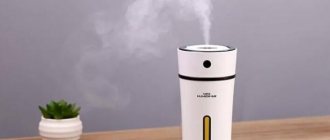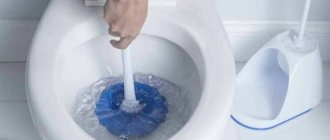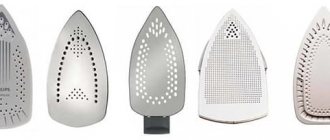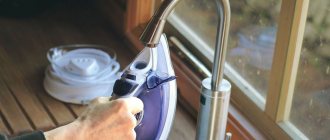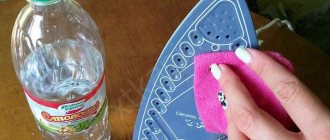Additional Cleaning and Prevention Tips
- If you burn the fabric and its traces remain on the sole, immediately apply a cotton rag soaked in cold water to the stained area. A sudden change in temperature will help peel off the burnt fabric from the metal.
- To reduce scale and rust deposits inside the iron, each time after ironing, while the appliance is still warm, pour out all remaining water from it.
- To delay descaling your iron, try to use filtered water for steaming.
Do not use metal sponges or hard brushes to clean the soleplate of the iron, especially if it has a Teflon or ceramic coating. Also, to avoid scratching the metal, avoid using abrasive cleaners.
And finally, we suggest watching a useful video on how to clean an iron with a metal, ceramic or Teflon sole using folk and special means.
Tap water is full of various impurities. They negatively affect the operation of steam generators and irons. Because of this, scale and rust form inside the device, which reduces the quality of ironing and damages the fabric. If the steam system is rarely used, the water tank may become moldy and green on the inside. It is important to know how to clean an iron from mold, rust and scale in order to extend its working life and avoid damage to fabrics.
Recommendations
- Some models have a special rod that attracts scale. To prevent the sole from leaking and staining in the future, remove the rod in a timely manner and do preventive maintenance. Namely: remove it and dip the object in a solution of citric acid for a couple of hours. Then rinse the rod with water, wipe it with a dry cloth and replace it.
- To prevent rust stains and salt deposits on the iron, do not use tap water. This also applies to boiled and melt water. Manufacturers of household appliances recommend adding the following water: demineralized, distilled, special for electrical appliances and filtered. But remember that distilled water must be diluted with regular water one to two before adding it to the iron.
Monitor your assistant regularly so that he does his job well and does not spoil your clothes.
Features of internal cleaning
If the iron spits rust, this may be due to the deterioration of the internal elements of the silicone steam generator. These parts are gaskets between the water tank and the base of the device.
- During prolonged use, the sole becomes hot. At the right time, the thermostat, which turns off the iron to prevent excessive overheating, does not work.
- The metal heats up to such an extent that it begins to affect the insulation of the silicone steam generator chamber.
- At a heating surface temperature of about 300 degrees, even heat-resistant silicone material melts.
- The iron begins to spit out brownish liquid. This is not rust, but molten silicone, similar in color to it.
It is necessary to replace a thermostat that has stopped working. The new unit will allow you to get rid of excessive overheating of the metal elements of the iron. If this is not done, the device may become unusable.
Real rust occurs not only due to poor quality water, but also due to a violation of the insulation of metal elements from moisture inside the steam generator chamber. If they are corroded, there is no point in repairing the device. If it’s just a matter of rusty or moldy stains due to bad water, the iron can be used quite well after proper cleaning.
Cautions from experts
There are products that you can use to clean your iron. However, their incorrect use can lead not only to a negative result, but also make the iron inoperable. This applies to the following:
- Incorrectly applied laundry soap or toothpaste can clog the holes in the device and completely ruin it. If the steam release function does not help, it is recommended to use cotton swabs or toothpicks (carefully, without scratching the surface of the iron).
- Avoid using aspirin, vinegar, or nail polish remover if the soleplate of the iron has not yet completely cooled. The fumes from such liquids are poisonous and can have a detrimental effect on your health and can also be life-threatening if the room is small and tightly closed.
- Do not pour vinegar directly onto the iron. It can get inside the device, damaging its internal parts and rubber components. Use swabs soaked in diluted vinegar.
- It is strictly forbidden to use acetic acid in its pure form to clean scale.
- Fine abrasives and table salt are not recommended for use in their pure form. It is necessary to make liquid formulations with their participation. Small particles can get inside the iron, clog it, and make it unsuitable for further use.
Related videos:
Cleaning accessories
Some models have a special self-cleaning system. For this purpose there is a special button located on the body of the device. According to the manual, heat the device to the required temperature. To start the cleaning process, press the button.
With such a system, any housewife will be able to clean the device without effort.
If rust and scale are not washed out of the iron, it is disassembled and all parts are washed manually. If you do not completely trust your knowledge of technology, it is better to entrust this activity to a professional.
Removing contaminants from the housing
You should clean the iron not only from the inside (from scale) or from the bottom (from stuck fabric). The body of the device also requires care. Over time, during use, dust and various contaminants accumulate on it, giving the device an extremely untidy appearance. The housing can be cleaned effectively and easily using the following products:
- acid solutions (citric, acetic acid);
- hydrogen peroxide;
- alcohol solution;
- vodka.
Clean the surface with a cloth soaked in the specified substance.
Household chemicals
If brownish or whitish stains appear on the sole, which differ from ordinary burnt marks, you can use Anti-scale. The process is simple. Following the instructions, dilute the product in water, then pour it into a container and heat the iron strongly. Turn it off and wait about 30 minutes. Drain the contaminated liquid and clean the container with clean water.
German-made compounds containing organic acids and anti-rust components also help: Topperr, Bosch, Filtero 605.
To clean the iron from rust inside with such preparations, follow this procedure:
- Dissolve the product in water in a ratio of 3:1.
- Preheat the iron by setting the control to maximum, and then turn it off.
- Pour the composition into the water inlet, place the device horizontally and wait 2 hours.
- Pour out the product and rinse the inside a couple of times with water.
Immediately before ironing, check the cleanliness of the appliance by releasing steam.
The drug “Silit” perfectly removes corrosion and scale. To clean the iron, you need to turn it upside down and carefully pour the cleaning agent drop by drop into the sole holes. After a few minutes, traces of rust will appear on the outside. Remove them with a dry cloth, then add water, and press the steam release buttons several times.
Eliminating synthetic burns with toothpaste
Detergents, antibacterial ingredients and abrasives make toothpaste an ideal assistant in cleaning various surfaces.
A practical, cheap, proven method is to clean the iron with toothpaste:
- Remove large pieces of burnt synthetic material (with a scraper or knife), and leave the device to cool.
- Apply toothpaste to a rough cloth and scrub the bottom in a circular motion.
Important! Toothpaste is also used by professional jewelers. It very gently and easily removes dirt from problem areas.
This method is especially suitable for ironing surfaces made of stainless steel.
Folk remedies
You can also clean your ironing device from traces of corrosion, lime and fungus using traditional methods. Mold marks will go away if you use recipes against rust and scale, but to remove mold forever, it is better to choose specific products.
Recipes against rust and scale
If the device spits out rusty liquid, or white scale stains remain on the fabric, compounds with high acidity are used. Usually vinegar or citric acid is used, but you can also use sparkling water.
Cleaning the device with vinegar:
- Pour vinegar mixed with water in equal parts into the iron, about a third of the capacity.
- Place the iron vertically and heat it to maximum, wait 5-10 minutes. During this time, the heating and cooling cycle will repeat, do not turn it off.
- Lift the appliance horizontally above a large bowl and press the steam release button. As a result, rusty liquid should flow out of the plantar holes. Let the steam flow until all dirt comes out of the ironing device.
- Fill the reservoir with clean water and heat the machine again to get rid of any remaining dirt and vinegar. Once or twice, without removing the basin, let off the steam.
Finally, pour out the water and wipe the surface and holes with a clean cloth.
Citric acid is even easier to use because it does not produce such unpleasant-smelling fumes as vinegar. You need to dilute a 25-gram package in 250 ml of warm water until completely dissolved. Then heat the iron and pour in the resulting mixture, wait 5-10 minutes.
Hold the device in a horizontal position over a basin and release steam several times so that dirty liquid comes out of the holes. After removing it, you need to pour out the liquid, pour in clean water and perform the same steps to remove any remaining scale. Then dry the sole and holes with a piece of cotton cloth.
It is safest to clean your iron with carbonated water. It is used not only for ironing equipment, but also for washing machines and kettles. You must proceed as follows:
- Fill the reservoir with water and heat the device at high temperatures.
- Disconnect from power supply.
- Shake the device.
- Place a piece of cotton under the iron and press the steam release button several times.
- Pour out the remaining water when the appliance has cooled completely.
Perform the manipulation several more times until completely cleaned.
Mold control compounds
Stains with a brownish, gray or greenish tint remaining on the fabric indicate the appearance of mold in the water compartment, and bright green spots indicate algae growth.
Ways to clean the inside of an iron from mold at home:
- Bleach. When preparing the solution, take one part of the drug to ten parts of water. The resulting composition is poured into the container. After about five minutes, the steam function turns on and the dirt comes down through the holes. Finally, the container is rinsed with boiled water.
- Ammonia. You can achieve the effect by making a mixture of water and alcohol and filling the water compartment with it for several hours. The solution is removed using the steam extraction function. Additionally, the steam outlets are cleaned. After cleansing, ammonia is washed off with boiled water.
- Hydrogen peroxide. The drug is poured into the water compartment, after ten minutes it can be cleaned. To speed up the process, use a narrow, hard brush.
- Tea tree oil. Enough 10 drops per 20 ml of water. The composition is poured into the reservoir of the device. Then you need to remove the liquid through the steam holes.
An old effective remedy is baking soda. It is non-toxic and gently acts on the walls of the container, removing mold bacteria and algae. The advantage of this method is that soda is able to absorb moisture, thereby preventing the further appearance of microorganisms. Clean the tank with an aqueous solution at the rate of 1/4 large spoon of powder per glass of boiled water.
If the water container is covered with algae that forms a green coating, it is cleaned with brown water. It is a natural, chemical-free, non-toxic product suitable for cleaning drains and toilets. Can be used as an insecticide in the fight against mold.
To remove greens from the device’s reservoir, you must:
- dilute 200 ml of the drug in 2.5 liters of water;
- Fill the container with the solution and clean it with a stiff brush;
- remove the remaining composition with purified water.
One rinse is enough to remove excess solution. The product remaining on the surface of the tank is not removed, as it will prevent the growth of bacteria.
What and how to wash the inside at home?
During the steaming process, water boils in the iron tank and, as a result, a coating of hardness salts (calcium and magnesium) forms on the heating element.
During operation of the device, sediment gradually accumulates and turns into hard scale, which interferes with the normal functioning of the device.
IMPORTANT! At the first signs of plaque and for preventive purposes, clean the electrical device once every 3-4 months.
Anti-corrosion care for irons
Like any household appliance, the iron requires protection against internal contamination. Then its service life will increase, and the laundry will not become dirty when ironing.
Follow these recommendations:
- do not iron synthetics at maximum temperature;
- monitor the quality of the water used;
- Always drain the container after ironing.
Do not use only distilled water for ironing. Its boiling point is higher, vaporization is worse, which can cause damage to the internal walls of the device. It is better to choose boiled. Hard water is mixed with distilled water in equal parts.
If rust marks appear on ironed laundry, it is worth disassembling the device. Perhaps the problem is the melting of silicone parts or corrosion of metal parts. In order not to aggravate the situation by cleaning, it is worth carrying out a preventive check and, if necessary, sending the iron for repair.
Tap water is full of various impurities. They negatively affect the operation of steam generators and irons. Because of this, scale and rust form inside the device, which reduces the quality of ironing and damages the fabric. If the steam system is rarely used, the water tank may become moldy and green on the inside. It is important to know how to clean an iron from mold, rust and scale in order to extend its working life and avoid damage to fabrics.
How to prevent scale formation
To avoid having to remove scale in the future, control the quality of the water you pour into the iron. The best way to do this is:
- Distilled water: available at any gas station.
- Bottled water from the nearest supermarket.
- Water purified using a home filter.
- Settled tap water: within a few hours, salts will precipitate.
Do you have your own secrets for cleaning household appliances? Share them in the comments!
Modern irons are very easy to use - thanks to the steaming function built into almost all models, housewives do not need to additionally use a spray bottle to moisten things when ironing.
Features of internal cleaning
If the iron spits rust, this may be due to the deterioration of the internal elements of the silicone steam generator. These parts are gaskets between the water tank and the base of the device.
- During prolonged use, the sole becomes hot. At the right time, the thermostat, which turns off the iron to prevent excessive overheating, does not work.
- The metal heats up to such an extent that it begins to affect the insulation of the silicone steam generator chamber.
- At a heating surface temperature of about 300 degrees, even heat-resistant silicone material melts.
- The iron begins to spit out brownish liquid. This is not rust, but molten silicone, similar in color to it.
It is necessary to replace a thermostat that has stopped working. The new unit will allow you to get rid of excessive overheating of the metal elements of the iron. If this is not done, the device may become unusable.
Real rust occurs not only due to poor quality water, but also due to a violation of the insulation of metal elements from moisture inside the steam generator chamber. If they are corroded, there is no point in repairing the device. If it’s just a matter of rusty or moldy stains due to bad water, the iron can be used quite well after proper cleaning.
Embedded Systems
Most iron models are equipped with built-in self-cleaning functions and anti-limescale systems.
Self-cleaning function from scale and rust
Perform the operation at least once every 2 months:
- prepare a container to drain dirty liquid from the iron;
- fill the tank with water;
- turn on the household appliance at full power, wait until it turns off automatically. Turn the device back on;
- When the iron turns off, place it in a horizontal position over your pelvis.
- press the self-cleaning button (“Calc Clean”): at the same time, steam with particles of plaque, rust and other contaminants will begin to emerge from the sole of the device;
- repeat the entire procedure 3-4 more times (until the device is completely clean);
- wait for the iron to cool completely, remove any remaining scale from the soleplate and the holes on it.
IMPORTANT! After self-cleaning, perform the first ironing on the old item.
Read also: Cheesecakes turned out liquid, what to do?
Anti-scale system
Steam generators and many models of irons with a steam function are equipped with additional devices that allow you to soften the water used to operate the devices: cassettes or anti-lime rods.
Cassettes can be replaceable (after a certain service life of the iron, they must be replaced with new ones) and permanent (valid throughout the entire service life of the iron).
Anti-lime rods are designed to last the entire “life” of a household appliance, but they also need to be periodically descaled (at least once every 2 months):
Cleaning accessories
Some models have a special self-cleaning system. For this purpose there is a special button located on the body of the device. According to the manual, heat the device to the required temperature. To start the cleaning process, press the button.
With such a system, any housewife will be able to clean the device without effort.
If rust and scale are not washed out of the iron, it is disassembled and all parts are washed manually. If you do not completely trust your knowledge of technology, it is better to entrust this activity to a professional.
Vinegar + water
Combine table vinegar + water in equal proportions 1:1 in a container. Place the iron vertically, pour liquid to the maximum, heat the iron and leave for 10 minutes. The iron will turn on and off at this time, do not interrupt this process. Then place a basin and start releasing steam from the iron. Continue until no more brown liquid comes out of the iron. Remember that during this procedure the windows in the house must be open! At the end, simply fill in the water, heat it again and release the steam to remove any remaining scale and vinegar. Wipe the iron with a cloth.
Household chemicals
If brownish or whitish stains appear on the sole, which differ from ordinary burnt marks, you can use Anti-scale. The process is simple. Following the instructions, dilute the product in water, then pour it into a container and heat the iron strongly. Turn it off and wait about 30 minutes. Drain the contaminated liquid and clean the container with clean water.
German-made compounds containing organic acids and anti-rust components also help: Topperr, Bosch, Filtero 605.
To clean the iron from rust inside with such preparations, follow this procedure:
- Dissolve the product in water in a ratio of 3:1.
- Preheat the iron by setting the control to maximum, and then turn it off.
- Pour the composition into the water inlet, place the device horizontally and wait 2 hours.
- Pour out the product and rinse the inside a couple of times with water.
Immediately before ironing, check the cleanliness of the appliance by releasing steam.
The drug “Silit” perfectly removes corrosion and scale. To clean the iron, you need to turn it upside down and carefully pour the cleaning agent drop by drop into the sole holes. After a few minutes, traces of rust will appear on the outside. Remove them with a dry cloth, then add water, and press the steam release buttons several times.
Cleaning durable surfaces
The soles made of titanium, stainless steel, and metal with sapphire coating are very durable, so abrasive substances can also be used when cleaning.
Salt
Salt is not harmful to hard surfaces; it acts as a kind of scrub. The salt poured onto a white paper sheet is “ironed” for a minute. It will darken and the sole will become clean. Melted synthetic material from a strong surface can be scraped off with a wooden spatula.
Matchbox
Or rather, not the whole box, but only sulfur applied to the side. Use this area to gently rub the dirt on the sole.
Paraffin
Before use, place a slightly heated iron in a tray so that the wax applied to the sole and melted by the temperature flows into the container and not onto things. You can remove any remaining paraffin by ironing the unwanted fabric.
Dishwashing liquid
Take baking soda, dilute it with liquid, and apply the resulting slurry to a cold sole. Leave for 10 minutes, rub the surface, then remove the mass with a damp cloth.
Important:
Even such surfaces should not be cleaned with sharp objects, sandpaper or a knife should be used. Scratches on the soleplate may impair the performance of the device.
Folk remedies
You can also clean your ironing device from traces of corrosion, lime and fungus using traditional methods. Mold marks will go away if you use recipes against rust and scale, but to remove mold forever, it is better to choose specific products.
Recipes against rust and scale
If the device spits out rusty liquid, or white scale stains remain on the fabric, compounds with high acidity are used. Usually vinegar or citric acid is used, but you can also use sparkling water.
Cleaning the device with vinegar:
- Pour vinegar mixed with water in equal parts into the iron, about a third of the capacity.
- Place the iron vertically and heat it to maximum, wait 5-10 minutes. During this time, the heating and cooling cycle will repeat, do not turn it off.
- Lift the appliance horizontally above a large bowl and press the steam release button. As a result, rusty liquid should flow out of the plantar holes. Let the steam flow until all dirt comes out of the ironing device.
- Fill the reservoir with clean water and heat the machine again to get rid of any remaining dirt and vinegar. Once or twice, without removing the basin, let off the steam.
Finally, pour out the water and wipe the surface and holes with a clean cloth.
Citric acid is even easier to use because it does not produce such unpleasant-smelling fumes as vinegar. You need to dilute a 25-gram package in 250 ml of warm water until completely dissolved. Then heat the iron and pour in the resulting mixture, wait 5-10 minutes.
Hold the device in a horizontal position over a basin and release steam several times so that dirty liquid comes out of the holes. After removing it, you need to pour out the liquid, pour in clean water and perform the same steps to remove any remaining scale. Then dry the sole and holes with a piece of cotton cloth.
It is safest to clean your iron with carbonated water. It is used not only for ironing equipment, but also for washing machines and kettles. You must proceed as follows:
- Fill the reservoir with water and heat the device at high temperatures.
- Disconnect from power supply.
- Shake the device.
- Place a piece of cotton under the iron and press the steam release button several times.
- Pour out the remaining water when the appliance has cooled completely.
Perform the manipulation several more times until completely cleaned.
Mold control compounds
Stains with a brownish, gray or greenish tint remaining on the fabric indicate the appearance of mold in the water compartment, and bright green spots indicate algae growth.
Ways to clean the inside of an iron from mold at home:
- Bleach. When preparing the solution, take one part of the drug to ten parts of water. The resulting composition is poured into the container. After about five minutes, the steam function turns on and the dirt comes down through the holes. Finally, the container is rinsed with boiled water.
- Ammonia. You can achieve the effect by making a mixture of water and alcohol and filling the water compartment with it for several hours. The solution is removed using the steam extraction function. Additionally, the steam outlets are cleaned. After cleansing, ammonia is washed off with boiled water.
- Hydrogen peroxide. The drug is poured into the water compartment, after ten minutes it can be cleaned. To speed up the process, use a narrow, hard brush.
- Tea tree oil. Enough 10 drops per 20 ml of water. The composition is poured into the reservoir of the device. Then you need to remove the liquid through the steam holes.
An old effective remedy is baking soda. It is non-toxic and gently acts on the walls of the container, removing mold bacteria and algae. The advantage of this method is that soda is able to absorb moisture, thereby preventing the further appearance of microorganisms. Clean the tank with an aqueous solution at the rate of 1/4 large spoon of powder per glass of boiled water.
If the water container is covered with algae that forms a green coating, it is cleaned with brown water. It is a natural, chemical-free, non-toxic product suitable for cleaning drains and toilets. Can be used as an insecticide in the fight against mold.
To remove greens from the device’s reservoir, you must:
- dilute 200 ml of the drug in 2.5 liters of water;
- Fill the container with the solution and clean it with a stiff brush;
- remove the remaining composition with purified water.
One rinse is enough to remove excess solution. The product remaining on the surface of the tank is not removed, as it will prevent the growth of bacteria.
What you have to clean
The device needs to be cleaned both inside and out. External surfaces are wiped regularly to remove dust and dirt. The lower part is freed from particles of burnt fabric and rust. The water container is protected from scale and sometimes mold.
What types of soles are there?
The quality of ironing directly depends on the condition of the main part of the iron. The material from which it is made is important.
The most inexpensive are aluminum and stainless steel. They heat up quickly, but fabric fibers stick to them, forming carbon deposits. Therefore, modern electrical appliances have additional coatings - titanium, ceramic, sapphire, enamel, or even mixed, for example, ceramics with silicon or titanium with sapphire. Manufacturers are constantly experimenting, inventing new types of soles. For example, metal-ceramics stands out among the new products.
Modern coatings have pros and cons:
- Titanium is durable, perfectly smooths out wrinkles, is scratch-resistant, and even metal buttons and locks are not afraid of it. But it takes a long time to warm up and is expensive.
- Ceramics and glass ceramics glide perfectly, clean quickly, do not leave a shine on the fabric, and heat up evenly. But they are prone to cracks and chips.
- Synthetics do not stick to Teflon; it glides easily even with low heat, but it can be easily scratched.
- Ceramic metal irons well and is easy to clean, but it also requires very careful handling.
- Sapphire is resistant to damage, but is expensive and does not heat up immediately.
- Enamel coating is also expensive.
Experts and housewives, based on the combination of qualities, give the palm to stainless steel and ceramics. Let's look at how to clean the soleplate of your iron.
Vinegar against mold - how effective is it?
When water blooms in the iron, vinegar essence can also help. Both pure and diluted, vinegar can get rid of 80% of bacterial species. Natural distilled vinegar is suitable for processing. The advantages of the product include:
- efficiency;
- naturalness;
- affordable price;
- ease of use.
The cleaning process is not difficult. Vinegar, concentrated or diluted, is poured into a water container and left for an hour or two, depending on the degree of contamination. After this time, turn on the steam function, releasing the solution along with the remaining mold. After treatment, the tank is rinsed again with clean water.
Preventive measures
Now let's look at how to prevent scale formation.
- Fill your iron with a steamer with distilled or bottled water. As a last resort - passed through a filter or settled.
- To prevent scale from forming, pour out any remaining water from the reservoir after ironing.
- Twice a month, turn on the self-cleaning function of the device.
- After ironing, wipe the iron with a damp cloth on all sides, clean the steam chamber, clean the safety valve or anti-lime rod.
- Periodically clean the electrical appliance from scale and rust.
Hydrogen peroxide and soda - simple methods to combat mold
When you need to clean a container of water from mold, hydrogen peroxide will help remove green deposits from the bottom and walls, providing protection against new formations for the future. The antifungal agent works well against mold, is safe, and does not contain toxins.
Removing mold with peroxide is easy. To do this, pour it into a container for no more than 10 minutes, speed up the process with a narrow, hard brush.
A simple and safe remedy is baking soda. The product is safe, does not release toxins, has a gentle effect on the walls of the tank, delicately removing traces of mold. The advantage of this method is the ability of soda to absorb moisture, which prevents the formation of bacteria in the future. To clean, mix soda with water at the rate of ¼ tablespoon per glass of distilled water.

